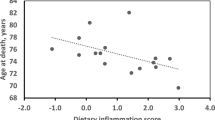Abstract
It is shown that differentiation of mouse mortality curves (number of animals that died at a certain age plotted versus their lifespan) results in the appearance of eight clearly distinguished clusters of peaks corresponding to increased mortality rates. Smoothing of the original mortality curves and subsequent transformation of the differential mortality curves according to the Gompertz model makes the peaks and the corresponding clusters less pronounced and drives the logarithm of the force mortality curve toward a straight line. The positions of the clusters on the lifespan axis (expressed in days) were calculated as weighted means by dividing the sum of the products of multiplication of the peak heights and their position on the lifespan axis by the sum of the peak heights within a cluster. To prove that the peaks and their clusters are not random, we have demonstrated that the positions of the clusters on the lifespan axis do not depend on the extent of mortality curve smoothing or the group of mice analyzed.
Similar content being viewed by others
References
Gompertz, B. (1825) On the nature of the function expres–sive of the law of human mortality and on a new mode of determining the value of life contingencies, Philos. Trans. Roy. Soc. London A, 115, 513–583.
Gavrilov, L. A., and Gavrilova, N. S. (1991) Biology of Longevity [in Russian], Nauka, Moscow.
Lamb, M. J. (1977) Biology of Aging, Blackie, Glasgow.
Mylnikov, S. V., Oparina, T. I., and Bychkovskaya, I. B. (2015) On the discontinuous character of annuity curves. Commu–nication 1. Deviations from the Gompertz law in Drosophila melanogaster Canton–S line, Usp. Gerontol., 28, 624–628.
Malygin, A. G. (2017) New data on programmed risks of death in normal mice and mutants with growth delay, Biochemistry (Moscow), 82, 834–843.
Malygin, A. G. (2012) Variations in the lifespan of mice during the periods of growth and aging, Dokl. MOIP Sekt. Gerontol., 50, 56–65.
Malygin, A. G. (2013) Graduated change of life expectan–cy in mice ontogenesis, Rus. J. Dev. Biol., 44, 48–55.
Malygin, A. G. (2013) Age fluctuations in mortality of mice with mutation causing growth retardation, Biochemistry (Moscow), 78, 1033–1042.
Makeham, W. M. (1860) On the law of mortality and the construction of annuity tables, J. Inst. Actuaries, 8, 301–310.
Skulachev, V. P. (2012) What is “phenoptosis” and how to fight it? Biochemistry (Moscow), 77, 827–846.
Skulachev, V. P., Skulachev, M. V., and Fenyuk, B. A. (2014) Life without Aging [in Russian], EKSMO, Moscow.
Anisimov, V. N. (2008) Molecular and Physiological Mechanisms of Aging [in Russian], Nauka, St. Petersburg.
Author information
Authors and Affiliations
Corresponding author
Additional information
Original Russian Text © A. G. Malygin, 2018, published in Biokhimiya, 2018, Vol. 83, No. 7, pp. 1067–1077.
Electronic supplementary material
Rights and permissions
About this article
Cite this article
Malygin, A.G. Reproducible Peak Clusters on Differential Mouse Mortality Curves and Their Relation to the Gompertz Model. Biochemistry Moscow 83, 836–845 (2018). https://doi.org/10.1134/S0006297918070076
Received:
Revised:
Published:
Issue Date:
DOI: https://doi.org/10.1134/S0006297918070076




